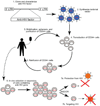Stem cell-based anti-HIV gene therapy
- PMID: 21247612
- PMCID: PMC3072166
- DOI: 10.1016/j.virol.2010.12.039
Stem cell-based anti-HIV gene therapy
Abstract
Human stem cell-based therapeutic intervention strategies for treating HIV infection have recently undergone a renaissance as a major focus of investigation. Unlike most conventional antiviral therapies, genetically engineered hematopoietic stem cells possess the capacity for prolonged self-renewal that would continuously produce protected immune cells to fight against HIV. A successful strategy therefore has the potential to stably control and ultimately eradicate HIV from patients by a single or minimal treatment. Recent progress in the development of new technologies and clinical trials sets the stage for the current generation of gene therapy approaches to combat HIV infection. In this review, we will discuss two major approaches that are currently underway in the development of stem cell-based gene therapy to target HIV: one that focuses on the protection of cells from productive infection with HIV, and the other that focuses on targeting immune cells to directly combat HIV infection.
Copyright © 2011 Elsevier Inc. All rights reserved.
Figures

Similar articles
-
Cell-based gene therapy against HIV.Gene Ther. 2015 Nov;22(11):851-5. doi: 10.1038/gt.2015.58. Epub 2015 Jun 16. Gene Ther. 2015. PMID: 26079406 Review.
-
Stem cell-based therapies for HIV/AIDS.Adv Drug Deliv Rev. 2016 Aug 1;103:187-201. doi: 10.1016/j.addr.2016.04.027. Epub 2016 May 2. Adv Drug Deliv Rev. 2016. PMID: 27151309 Free PMC article. Review.
-
Stem cell-based approaches to treating HIV infection.Curr Opin HIV AIDS. 2011 Jan;6(1):68-73. doi: 10.1097/COH.0b013e3283412370. Curr Opin HIV AIDS. 2011. PMID: 21242896 Free PMC article. Review.
-
CCR5-targeted hematopoietic stem cell gene approaches for HIV disease: current progress and future prospects.Curr Stem Cell Res Ther. 2012 Jul;7(4):310-7. doi: 10.2174/157488812800793108. Curr Stem Cell Res Ther. 2012. PMID: 22486585 Review.
-
CCR5Δ32 mutation and HIV infection: basis for curative HIV therapy.Curr Opin Virol. 2015 Oct;14:24-9. doi: 10.1016/j.coviro.2015.06.007. Epub 2015 Jul 1. Curr Opin Virol. 2015. PMID: 26143158 Review.
Cited by
-
CCR5 as a natural and modulated target for inhibition of HIV.Viruses. 2013 Dec 30;6(1):54-68. doi: 10.3390/v6010054. Viruses. 2013. PMID: 24381033 Free PMC article.
-
Expression of chimeric receptor CD4ζ by natural killer cells derived from human pluripotent stem cells improves in vitro activity but does not enhance suppression of HIV infection in vivo.Stem Cells. 2014 Apr;32(4):1021-31. doi: 10.1002/stem.1611. Stem Cells. 2014. PMID: 24307574 Free PMC article.
-
Cell-based gene therapy against HIV.Gene Ther. 2015 Nov;22(11):851-5. doi: 10.1038/gt.2015.58. Epub 2015 Jun 16. Gene Ther. 2015. PMID: 26079406 Review.
-
Lens epithelium-derived growth factor/p75 qualifies as a target for HIV gene therapy in the NSG mouse model.Mol Ther. 2012 May;20(5):908-17. doi: 10.1038/mt.2012.6. Epub 2012 Feb 14. Mol Ther. 2012. PMID: 22334021 Free PMC article.
-
Stem Cell Therapy and Its Significance in HIV Infection.Cureus. 2021 Aug 27;13(8):e17507. doi: 10.7759/cureus.17507. eCollection 2021 Aug. Cureus. 2021. PMID: 34595076 Free PMC article. Review.
References
-
- Aiuti A, Cattaneo F, Galimberti S, Benninghoff U, Cassani B, Callegaro L, Scaramuzza S, Andolfi G, Mirolo M, Brigida I, Tabucchi A, Carlucci F, Eibl M, Aker M, Slavin S, Al-Mousa H, Al Ghonaium A, Ferster A, Duppenthaler A, Notarangelo L, Wintergerst U, Buckley RH, Bregni M, Marktel S, Valsecchi MG, Rossi P, Ciceri F, Miniero R, Bordignon C, Roncarolo MG. Gene therapy for immunodeficiency due to adenosine deaminase deficiency. N Engl J Med. 2009;360(5):447–458. - PubMed
-
- Alanio C, Lemaitre F, Law HK, Hasan M, Albert ML. Enumeration of human antigen-specific naive CD8+ T cells reveals conserved precursor frequencies. Blood. 2010;115(18):3718–3725. - PubMed
-
- Alkhatib G, Combadiere C, Broder CC, Feng Y, Kennedy PE, Murphy PM, Berger EA. CC CKR5: a RANTES, MIP-1alpha, MIP- 1beta receptor as a fusion cofactor for macrophage-tropic HIV-1. Science. 1996;272(5270):1955–1958. - PubMed
-
- Amado RG, Mitsuyasu RT, Rosenblatt JD, Ngok FK, Bakker A, Cole S, Chorn N, Lin LS, Bristol G, Boyd MP, MacPherson JL, Fanning GC, Todd AV, Ely JA, Zack JA, Symonds GP. Anti-human immunodeficiency virus hematopoietic progenitor cell-delivered ribozyme in a phase I study: myeloid and lymphoid reconstitution in human immunodeficiency virus type-1-infected patients. Hum Gene Ther. 2004;15(3):251–262. - PubMed
Publication types
MeSH terms
Grants and funding
LinkOut - more resources
Full Text Sources
Other Literature Sources
Medical

